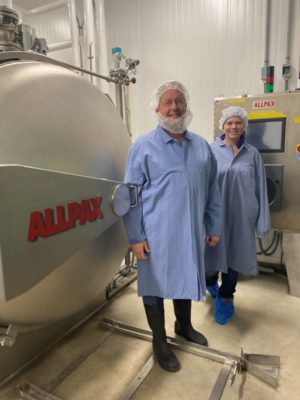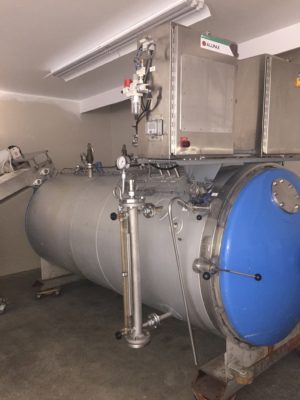Powering the process: Retorts help steer products to market
When Jeff Rome decided to scale up his family sauerkraut business, he quickly learned he would need more advanced equipment.
“At times, it was not always easy to pull in labor of family and friends,” said Rome, a founding member of Hoganville Family Farms in Olathe, Kansas. “That was where we started realizing that if we want to keep growing the operation, we’re going to have to do some automation, because eventually family and friends are not going to want to come help us. It’s like we were calling them up and asking them to come help us move.”
In 2011, the family business produced a 1,500-pound test run. A decade later, annual output had grown to 100,000 pounds, with hand-packing in 12- and 24-ounce jars by 25 seasonal employees becoming an ever-increasing challenge.
“It was a lot of work, a lot of manual labor,” Rome said. “It was: Load the trays up with jars, manually stack the trays, and then take the trays and place them in the water bath. Let it cook, with a manual valve trying to maintain temperature. And once we hit our time, we would have to make sure that our temperatures were consistent with our cooking process. And then once that was completed, take the trays out of the water bath, let them cool off, place the jars on a pallet, let them cool off.
“It was just too much handling for one jar. It was a lot for four to five guys.”

Rome found his answer in a retort, a pressure vessel used to commercially sterilize food using high heat. Food is filled into pouches or cans, sealed, and heated in an automated process that kills pathogens and prolongs shelf life.
“The introduction of the retort was a learning curve, at first. Just like any other piece of equipment, it takes a little while to learn it,” Rome said.
The results, however, have been transformational.
“With the cooking process, we don’t dread it anymore. We actually look forward to it,” he said.
In a stroke of luck for the mom-and-pop operation, Rome found a vintage 1984 batch retort, originally used in test marketing and cheaper than new models, which can cost thousands of dollars. With the help of leading retort designer and manufacturer Allpax, the three-basket unit was refurbished into a workable solution that has accelerated Hoganville Family Farm’s automation process while helping Rome avoid alienating overworked relatives and friends.
“That’s the only way we could have gotten into this,” Rome said. “We don’t have the income that a lot of these major corporate companies do, and we have to live on secondhand equipment. We’re just happy with bringing it back to life and getting some more use out of it.”
Equipment refurbishing is a service offered by Allpax, a product brand of global packaging leader ProMach. The company provides equipment and services for a range of retort users, from startups like Hoganville to large, multinational companies.
“We offer all different types and sizes of retorts, including both pilot- and production-sized retorts,” said Jeff Arthur, Allpax technical sales director. “We also design and manufacture the automation equipment that goes along with it. In a retort system, either containers, like cans or glass jars, are loaded into a basket, or flexible containers, like plastic pouches, cups or bowls, are loaded onto self-supporting trays that are stacked on top of each other to form a cube. Then, in the most modern automated retort systems, conveyors, shuttles or automatic guided vehicles are used to transport the baskets or tray stack cubes to and from the retorts and the loading and unloading equipment. We call that retort delivery equipment. We design and manufacture all of that equipment as well.”
In search of the magic bean
Michigan State University’s Food Processing and Innovation Center, which opened in 2018, uses Allpax equipment to test new products and help get those products to market.
“Our reason for existence is outreach and new product development with both small and large entrepreneurs and food businesses,” said Mollie Woods, director of the Michigan State University Extension Product Center, which houses the food processing arm. “Some of the clients who come here are just doing proof of concept — can they scale up their product? Does it taste as good as when they’re just making it in a small batch? Can it handle the heat and pressure of commercial retorts?”

The Food Processing and Innovation Center also does a limited amount of co-packing for clients looking to scale up to working with a large co-packer or owning their own retort. Also a licensed canning facility, the center works with clients to develop and file their process with the Food and Drug Administration.
“We will do that for clients using the Allpax retort here,” Woods said. “It’s very rewarding. It’s nice to be able to help. I have a commodity background so it’s nice to be able to work with those commodity partners and help the commodity industries — the farmers in Michigan as well as the food processors all the way up to commercialization.”
While prohibited by clients’ nondisclosure agreements from discussing specific products, Woods said the center has seen a lot of interest recently in canning beverages, as well as intriguing projects in pet food and more demand for pouch processing. Another ongoing project involves clinical trials at other universities gauging whether certain foods improve patient outcomes during various treatments, while an upcoming federally funded project will examine plant-based proteins in MREs.
In 2021, the center worked with 62 clients, developing 22 new products or processes and operating for 130 production days, Woods said.
A key client is the state’s dry bean industry, which works closely with MSU to develop new varieties and assess how those varieties maintain their color and consistency during the retort process and in the can.
“On the production side, it might be a really great bean to grow, but if that bean then doesn’t survive in the can, it’s not worth very much to the industry,” Woods said. “What we’re looking for is the magic bean that is really good for farmers, is really good in the can, and tastes really good.”
Formerly the executive director of the Cherry Industry Administrative Board in Michigan, Woods came to MSU partly because of the university’s focus on new product development.
“My hope is that other commodity businesses might see what a resource this is and help to fund some of those projects for people, either at universities or working together with a group of companies,” she said.
Becoming a household name
From helping a family business automate its packaging to aiding in the hunt for the magic bean, retorts play a crucial role in produce processing. And like the products it helps bring to market, retort technology is constantly advancing, Arthur said.
“The industry has moved on from the very old, antiquated, mild steel, manually operated retort systems of the past,” he said. “Today’s fully automated systems are far from that. These systems are state-of-the-art, only requiring one or two people to operate — even when, in some cases, the systems can be massive.”
As the ramifications of the COVID-19 pandemic continue to exacerbate labor shortage issues, Arthur expects more processors to shift toward automated systems.
“Processors are looking to automate and reduce the amount of labor that it takes to get the product out the door. I think you’ll see this trend continuing to accelerate in the industry going forward.”
The difference made by the batch retort Hoganville uses has led to a satisfying, preservative-free product while making the production process easier. While still canning in jars as he works to find a workable bagging solution, Rome is enjoying the increased fruits of less labor.
“After we pack the jars manually, then we just take the jars and we place them in our retort baskets and stack the jars four high, and then we just roll them into the retort,” he said. “Once we do that, we’re able to do about 800 jars at one time. We close the door and make sure our equipment meets the parameters and hit the start button. We watch it do its thing for about an hour and 20 minutes, and once it completes the cooking recipe, we open the door and the product is nice and cool. We just wheel the trays out, take the jars off and we stack them on a pallet, and we don’t have to touch them ever again.
“The consistency of our product is what we want every time. It just looks beautiful.”
Such details are important to the Rome family, whose patriarch, Ray Rome, began handing out jars of his homemade Bavarian-style sauerkraut in the mid-1980s. The simple family recipe of sliced cabbage and salt and water allows for natural fermentation and does not permit the use of vinegar to accelerate that process.
“Everybody in our family was against preservatives,” Rome said. “It should maintain itself. It’s a sauerkraut. And when you look at nine out 10 sauerkrauts on the shelf, they all have preservatives in them, and they simply are not as flavorful as ours.”

Introducing the retort has allowed Hoganville to maintain that natural focus while scaling up automated production.
“Maintaining a cooking recipe, that’s what the retort did,” Rome said. “If we’re driving down a two-lane road, we’re going to be bouncing from lane to lane, but if we have an automated driving car, that car should be able to maintain the center of your driving lane. That’s what the retort allowed us to do, was to maintain the cooking recipe.”
Rome hopes that as his company continues to grow, more people get to experience the time and taste that goes into his family’s sauerkraut.
“I would love for us to become a household name with sauerkraut. I would like to see the whole image of sauerkraut turned around, as it can be a flavorful food for the palate,” he said. “When we do festivals where we sample our sauerkraut and we get a small family that comes to our booth, a lot of the times the kids will come up and say, ‘Yeah, I’d like to try it.’ But then the parents will say, ‘Oh, you’re not going to like that.’ That is what’s disappointing.
“To bring the open-mindedness back towards sauerkraut would be a really good direction for this to go in.”










